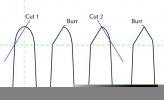I posted this once on another forum and was told it was helpful, so here goes:
- Soak the stones in water for about an hour or a half hour prior to use. This is more important for the finer grits; the medium and coarse stones don't require as much soaking to be used effectively.
- Get a coarse stone for re-profiling. They work much faster than the medium stone. Another alternative is to try the diamond stones that Ben offers but doesn't advertise (I haven't tried them yet myself).
- Tape the blade with some blue masking tape if you don't want it to be scratched. You don't want to learn this one the hard way. Again, this is more of a problem with the coarse and medium grits.
- KEEP YOUR STONES FLAT! One more time, KEEP YOUR STONES FLAT! I'm still looking for the best way to do this, I'm probably going to try the Stone Pond from Lee Valley Tool. If the stones are dished, they don't work as well.
- Make sure you have established a burr on both sides before moving on to the next grit stone. The wear rates for the different grits are different, so the fine grit stones are generally thicker after a long period of use than the coarse and medium grits, which means they grind the bevel at a slightly different angle than the finer grits. You may need to put a little bit of time in with the fine stone to raise a burr even after establishing the bevel with the medium. This becomes less of a problem after multiple sharpenings with the Edge Pro.
- The magic marker trick is your friend. See the Edge Pro website for details.
- Keep the stones wet during use. They have a tendency to glaze over if you don't.
- Don't use too much pressure. It just dishes the stones quicker.
- If you have to grind with the stone for a long time to establsh a bevel, remove the stone from the arm periodically and flip it end-for-end before you reinstall it. This helps to even out stone wear.
- As a finishing step, I sometimes raise the arm very slightly on the guide rod, say 1/32", and make a few very light swipes along the edge. Alternate sides a few times and use minimal pressure. This can be done with the finishing tape too. It helps to knock off a persistent burr.
- When in doubt, call Ben. He's a great guy and will gladly help you out.

